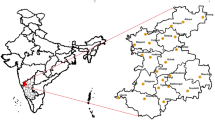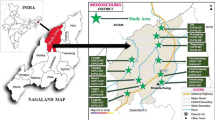Abstract
Radon, thoron, and their progeny concentrations, seasonal variation in the indoor environment have been measured for dose assessment to the residents for first time using a single-entry pinhole dosimeters and deposition-based radon/thoron progeny sensors. A total of 100 dosimeters were deployed in 25 villages. These values are found to be higher in winter than rainy and summer season which may be due to inadequate ventilation conditions. The average annual effective inhalation dose has been found to be 0.90 mSvy−1, which is below the recommended level of International Commission on Radiological Protection.








Similar content being viewed by others
Availability of data and materials
Not Applicable.
References
Eisenbud M (1963) Environmental radioactivity. McGraw-Hill, Newyork
Andersson HEB, Klevard Setterwall A (1996) The energy book, A resume of present knowledge and research, The Swedish council for building research, ISBN 91-540-5744-2, Stockholm, Sweden.
Nazaroff WW, Nero AV (1988) Radon and its decay products in indoor air. John Wiley and Sons, Newyork
Sahoo BK, Sapra BK et al (2013) A new pinhole discriminated 222Rn/220Rn passive measurement device with single entry face. Radiat Meas 58:52–60
Deborah TE, Kameswra M, Sridhar C (2020) Determination of residential soil gas radon risk indices over the lithological units of a Southwestern Nigeria University. Sci Rep Nat 10:7368. https://doi.org/10.1038/s41598-020-64217-8
Martz DE, Rood AS, George JL, Pearson MD, Langner JH (1991) Year to year variations in annual average indoor radon concentrations. Health Phys 61:409–413
Ramola RC, Kandari MS, Negi MS, Choubey VM (2000) A study of diurnal variation of indoor radon concentration. Health Phys 35:211–216
Mehra R, Bala P (2013) Estimation of annual effective dose from indoor radon/thoron cocentrations and measurement of radon concentrations in soil. Radiat Prot Dosim. https://doi.org/10.1093/rpd/nct191
Fleischer RL, Price PB, Walker RMM (1975) Nuclear tracks in solids: principles and applications. University of California Press, Berkeley
Singh B, Kaint K et al (2019) A study of seasonal variations of radon, thoron and their progeny levels in different types of dwellings in Faridabad district, Southern Haryana, India. J Radioana Nucl Chem 320(3):841–857
Nazir S, Simnani S et al (2020) Simultanous measurements of radon, thoron and their progeny for inhalation dose assessment in indoors of Srinagar, J&K, India. J Radioanal Nucl Chem 325:315–328
Nazir S, Sahoo BK, Rani S et al (2021) Radon mapping in groundwater and indoor environs of Budgam, Jammu and Kashmir. J Radioanal Nucl Chem 329:923–934
El-Hussein A, Ahmed AA, Mohamad A (1998) Radiation dose to the human respiratory tract from inhalation of radon-222 and its progeny. Appl Radiat Isot. https://doi.org/10.1016/S0969-8043(97)10002-1
Singla AK, Kansal S, Mehra R (2021) Dose distribution to individual tissues and organs due to exposure of alpha energies from radon and thoron to local population of Hanumangarh, Rajasthan, India. J Radioanal Nucl Chem 327(3):1073–1085
Khan HA, Qureshi IE, Tufail M (1993) Passive dosimetry of radon and its daughters using SSNTDs. Radiat Prot Dosim 46(3):149–170
WHO (2009) Indoor radon a public health perspective. Public Health Perspective
Ramola RC, Parshad M et al (2016) Dose estimation derived from the exposure to radon, thoron and their progeny in the indoor environment. Sci Rep 6:31061
Henshaw DL, Eatough JP, Raichanderson RB (1990) Radon as a causative factor in induction of myeloid leukemia and other cancers. Lancet 355:1008–1015
Beir VI (1999) Report of the committee on the biological effects of ionizing radiation: health effects of exposure to radon. Natl Res Council Acad Press, Washington
UNSCEAR United Nations Scientific Committee on the effects of atomic radiation (2000) Annex B: exposures from natural radiation sources. United Nations, New York
Lubin JH, Boice JD Jr (1997) Lung cancer risk from residential radon: meta analysis of eight epidemiological studies. J Natl Cancer Inst 89:49–57
Krewski D, Lubin JH (2005) Residential radon and risk of lung cancer a combined analysis of 7 North American case control studies. Epidemiology 16(2):137–145
Darby S, Hill D, Auvinen A, Barros-Dios JM, Baysson M, Bochicchio F, Deo H, Falk R, Forastiere F, Hakama M, Heid I, Kreienbrock L, Kreuzer M, Lagarde F, MäkeläinenI M, Oberaigner W, Pershagen G, Ruano-Ravina A, Ruosteenoja E, Schaffrath Rosario A, Tirmarche M, Tomásek M, Whitley E, Wichmann H-E, Doll R (2005) Radon in homes and risk of lung cancer: collaborative analysis of individual data from 13 European case-control studies. Br Med J 330:223
Sonkawde RG, Ram R (2003) Radon in tube-well drinking water and indoor air. Indoor Built Environ 13:383–385
Singla AK, Kansal S, Mehra M (2021) Quantification of radon contamination in drinking water of Rajasthan, India. J Radioanal Nucl Chem 327(3):1149–1157
Rani S, Kansal S, Singla AK, Mehra R (2021) Radiological risk assessment to the public due to the presence of radon in water of Barnala district, Punjab, India. Environ Geochem Health 43:5011–5024
Singla AK, Kanse S, Kansal S, Rani S, Mehra R (2022) A comprehensive study of radon in drinking waters of Hanumangarh district and the assessment of resulting dose to local population. Environ Geochem Health. https://doi.org/10.1007/s10653-022-01304-x
Rani S, Kansal S, Singla AK, Nazir S, Mehra M (2022) A comprehensive study of exhalation rates in soil samples to understand the high risk potential area in Barnala and Moga districts of Punjab, India. J Radioanal Nucl Chem 331:1889–1897
EPA (2011) Assessment of risk from radon in homes, U.S. Environmental Protection Agency. https://www.epa.gov/sites/default/files/2015-05/documents/402-r-03-003.pdf
Richardson RB, Eatough JP, Henshaw DL (1991) Dose to red bone marrow from natural radon and thoron exposure. Br J Radiol 1(64):608–624
Kaur K, Heer MS, Mehra R, Sahota HS (2019) Seasonal variation of indoor radon and thoron in the dwellings of Bathinda district of Punjab, India. Asian J Biol Life Sci 8(2):68–75
Godara N (2015) A review study of Malwa region of Punjab: as a cancer belt. IJAR 3:145–147
Kochhar N, Dadwal V, Rishi M, Sharma NK, Balaram V (2012) Evaluation of chemical quality of groundwater in parts of Sirsa (Harayana), Mansa, Bhatinda, and Muktsar districts, SW Punjab with emphasis on uranium in relation to human health. In: Proceedings of IGWC-2012 on the assessment and management of groundwater resources in hard rock systems with special reference to basaltic terrain, pp 611–626
Kumar A, Singh CK (2015) Characterization of hydrogeochemical processes and fluoride enrichment in groundwater of south-western Punjab. Water Qual Expo Health 7(3):373–387
Sapra BK, Sahoo BK, Mishra R, Kanse SD, Rout RP, Aggarwal TK, Prajith R, Gaware JJ, JalaluddinS, Kumbhar DS (2010) Handbook on radon transport models and measurement methods developed by BARC. RPAD, Health Safety and Environment Group, BARC, Mumbai, 51, 2010
Eappen KP, Sahoo BK (2008) Calibration factor for thoron estimation in cup dosimeter. Radiat Meas 43(1):S418–S421
Chauhan RP, Kumar A, Chauhan N, Joshi M, Aggarwal P, Sahoo BK (2014) Ventilation effect on indoor radon–thoron levels in dwellings and correlation with soil exhalation rates. Indoor Built Environ 25(1):203–212
Singla AK, Kansal S, Rani S, Mehra R (2021) Radiological risk assessment due to attached/unattached fractions of radon and thoron progeny in Hanumangarh district, Rajasthan. J Radioanal Nucl Chem 330:1473–1483
Cotar MF, Geraldo LP (1981) Studies of alpha particle registration in LR-115 Type-II a solid state nuclear track detector. Centro De Operação E Utilização Do Revtor De Pesquisas—Courp Area De Ftsica Nuclear
Mishra R, Mayya YS (2008) Study of deposition-based direct thoron progeny sensors (DTPS) technique for estimating equilibrium equivalent thoron concentration (EETC) in indoor environment. Radiat Meas 43:1408–1416
Singh P, Saini K et al (2015) Attached, unattached fraction of progeny concentration and equilibrium factor for dose assessment for radon and thoron. Radiat Environ Biophys 55:401–410
Mishra R, Mayya YS, Kushwaha HS (2009) Measurement of 220Rn/222Rn progeny deposition velocities on surfaces and their comparison with theoretical models. J Aerosol Sci 40(1):1–15
Eappen KP, Mayya YS (2004) Calibration factors for LR-115 (Type-II) based radon thoron discriminating dosimeter. Radiat Meas 38:5–17
ICRP (2018) International commission on radiological protection, radiological protection against radon exposure, ICRP ref 4836-9756-8598.
Pyngrope A, Khardewsaw et al (2020) A study of indoor radon, thoron and their progeny in South West Khasi Hills District of Meghalaya, India. Radiat Prot Dosim 189(3):347–353
Kandari T, Aswal S, Prasad M, Bourai AA, Ramola RC (2016) Estimation of annual effective dose from radon concentration along main boundary thrust (MBT) in Garhwal Himalaya. J Radiat Res Appl Sci 9–3:228–233
Narasimhamurthy KN, Ashok GV, Kumar TSS, Nagaiah N (2020) The 222Rn and 220Rn concentrations in some dwellings of Mandya city and its surroundings, Karnataka, India. Indoor Built Environ 30:1–10
Singh I, Kumar A, Rawat RBS (2016) Study of radon and thoron concentration in environment of Moradabad district of Uttar Pradesh, India. Green Chem Technol Lett 2(4):171–176
Acknowledgements
The authors are thankful to the residents of the study area for their cooperation. We are highly thankful to the anonymous reviewers for their comments which greatly improved the structure of this manuscript.
Funding
Self-financed.
Author information
Authors and Affiliations
Contributions
SR and SK designed the research plan and wrote the manuscript with contributions from AKS, SN and RM. Supriya Rani carried out all the radioactive surveys and analyses. All authors read and approved the final manuscript.
Corresponding author
Ethics declarations
Conflict of interest
On behalf of all authors, the corresponding author states that there is no conflict of interest.
Ethical approval
All the authors have read and approved the manuscript.
Consent to participate
Not Applicable.
Consent to publication
All authors have read and approved the final manuscript.
Additional information
Publisher's Note
Springer Nature remains neutral with regard to jurisdictional claims in published maps and institutional affiliations.
Rights and permissions
Springer Nature or its licensor (e.g. a society or other partner) holds exclusive rights to this article under a publishing agreement with the author(s) or other rightsholder(s); author self-archiving of the accepted manuscript version of this article is solely governed by the terms of such publishing agreement and applicable law.
About this article
Cite this article
Rani, S., Kansal, S., Singla, A.K. et al. Investigation of indoor 222Rn, 220Rn and their progeny in Punjab, northwestern India. J Radioanal Nucl Chem 332, 1–13 (2023). https://doi.org/10.1007/s10967-022-08674-7
Received:
Accepted:
Published:
Issue Date:
DOI: https://doi.org/10.1007/s10967-022-08674-7




